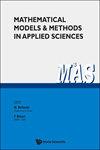Nose-Hoover振子的复杂性测度和一种可能的新的混沌产生机制
IF 3
1区 数学
Q1 MATHEMATICS, APPLIED
Mathematical Models & Methods in Applied Sciences
Pub Date : 2023-01-01
DOI:10.12988/ams.2023.917477
引用次数: 1
摘要
流行病学非线性模型的数学分析引起了人们对丙型肝炎病毒(HCV)感染机制的深入了解。在这篇文章中,我们提供了一个慢性HCV感染模型的免疫反应的研究,结合树突状细胞(DC)和细胞毒性T淋巴细胞(CTL)的作用。考虑到最近与同伦分析方法(HAM)相关的文献发展,我们计算了HCV模型的显式级数解,重点分析了一组特定的动态变量。采用最优同伦分析方法,通过选取合适的收敛控制参数值,提高了HAM的计算效率,极大地加快了序列解的收敛速度。近似的解析解,随着参数的变化,表示CTL的膨胀率,被用来计算密度图,这使我们能够讨论模型的其他动态特征本文章由计算机程序翻译,如有差异,请以英文原文为准。
Measures of complexity in Nose-Hoover oscillator and a possible new chaos generation mechanism
Mathematical analysis of nonlinear models in epidemiology has generated a deep interest in gaining insights into the mechanisms that underlie hepatitis C virus (HCV) infections. In this article, we provide a study of a chronic HCV infection model with immune response, incorporating the effect of dendritic cells (DC) and cytotoxic T lymphocytes (CTL). Considering very recent developments in the literature related to the Homotopy Analysis Method (HAM), we calculate the explicit series solutions of the HCV model, focusing our analysis on a particular set of dynamical variables. An optimal homotopy analysis approach is used to improve the computational efficiency of HAM by means of appropriate values for a convergence control parameter, which greatly accelerates the convergence of the series solutions. The approximated analytical solutions, with the variation of a parameter representing the expansion rate of CTL, are used to compute density plots, which allow us to discuss additional dynamical features of the model
求助全文
通过发布文献求助,成功后即可免费获取论文全文。
去求助
来源期刊
CiteScore
6.30
自引率
17.10%
发文量
61
审稿时长
1 months
期刊介绍:
The purpose of this journal is to provide a medium of exchange for scientists engaged in applied sciences (physics, mathematical physics, natural, and technological sciences) where there exists a non-trivial interplay between mathematics, mathematical modelling of real systems and mathematical and computer methods oriented towards the qualitative and quantitative analysis of real physical systems.
The principal areas of interest of this journal are the following:
1.Mathematical modelling of systems in applied sciences;
2.Mathematical methods for the qualitative and quantitative analysis of models of mathematical physics and technological sciences;
3.Numerical and computer treatment of mathematical models or real systems.
Special attention will be paid to the analysis of nonlinearities and stochastic aspects.
Within the above limitation, scientists in all fields which employ mathematics are encouraged to submit research and review papers to the journal. Both theoretical and applied papers will be considered for publication. High quality, novelty of the content and potential for the applications to modern problems in applied sciences and technology will be the guidelines for the selection of papers to be published in the journal. This journal publishes only articles with original and innovative contents.
Book reviews, announcements and tutorial articles will be featured occasionally.

 求助内容:
求助内容: 应助结果提醒方式:
应助结果提醒方式:


